Exploring Alcohol Consumption in the UK: A Research Report
VerifiedAdded on 2022/12/27
|29
|4173
|63
Report
AI Summary
This research report analyzes data from the Health Survey for England 2011 to explore alcohol consumption patterns in the UK. The study examines a sample of 10,617 participants, providing insights into the percentage of people who drink alcohol, the gender distribution, educational levels, marital status, and ethnic origin. The report presents statistical measures such as mean, median, mode, minimum, maximum, and range for household size and age. Cross-tabulation analysis reveals which gender and region consume alcohol most frequently. Furthermore, the report investigates correlations between various factors, including gender, income, and age, and their relationship to alcohol consumption. The discussion section interprets the findings and considers the implications for preventing and controlling alcohol use in the UK, culminating in conclusions and recommendations for future interventions.
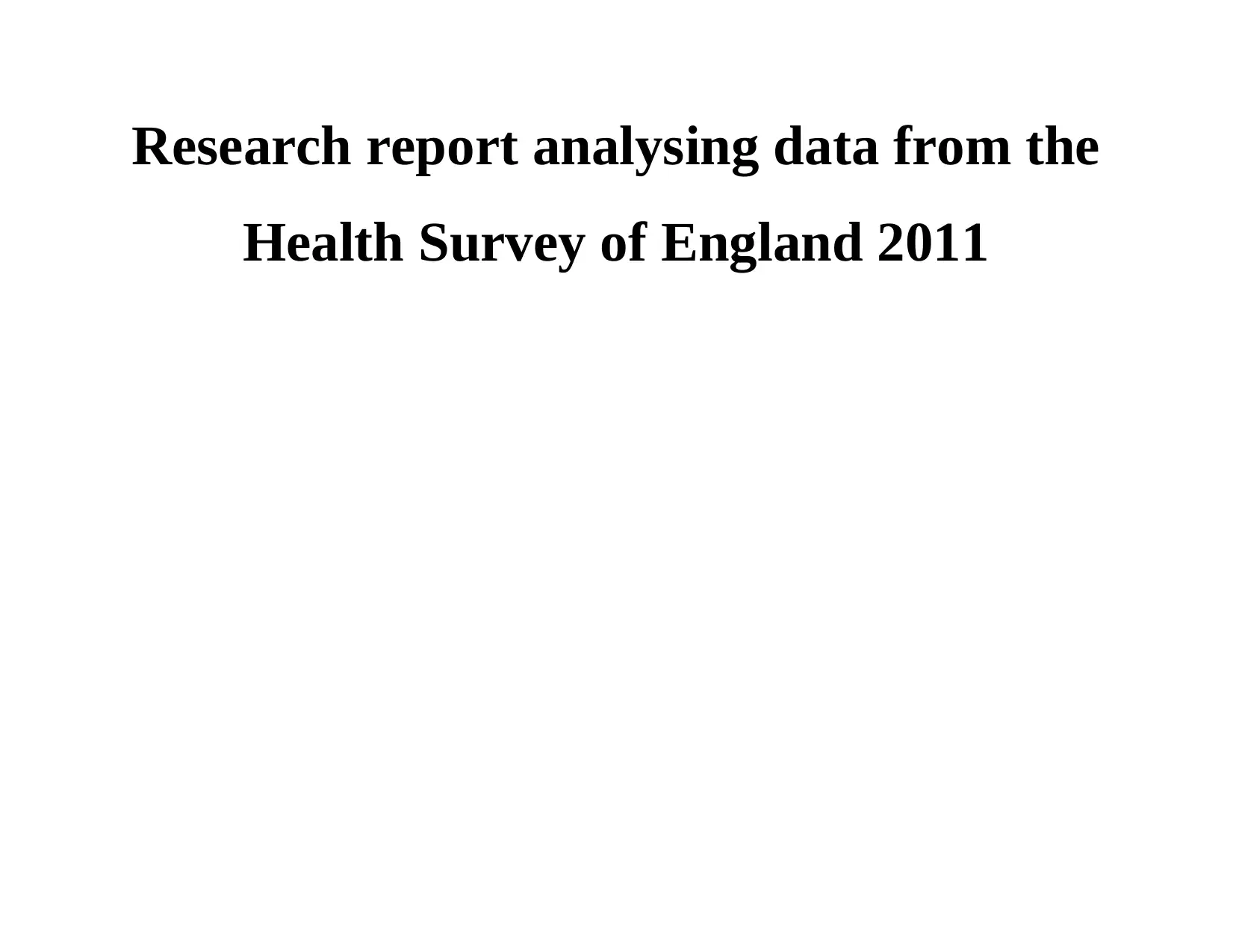
Research report analysing data from the
Health Survey of England 2011
Health Survey of England 2011
Paraphrase This Document
Need a fresh take? Get an instant paraphrase of this document with our AI Paraphraser
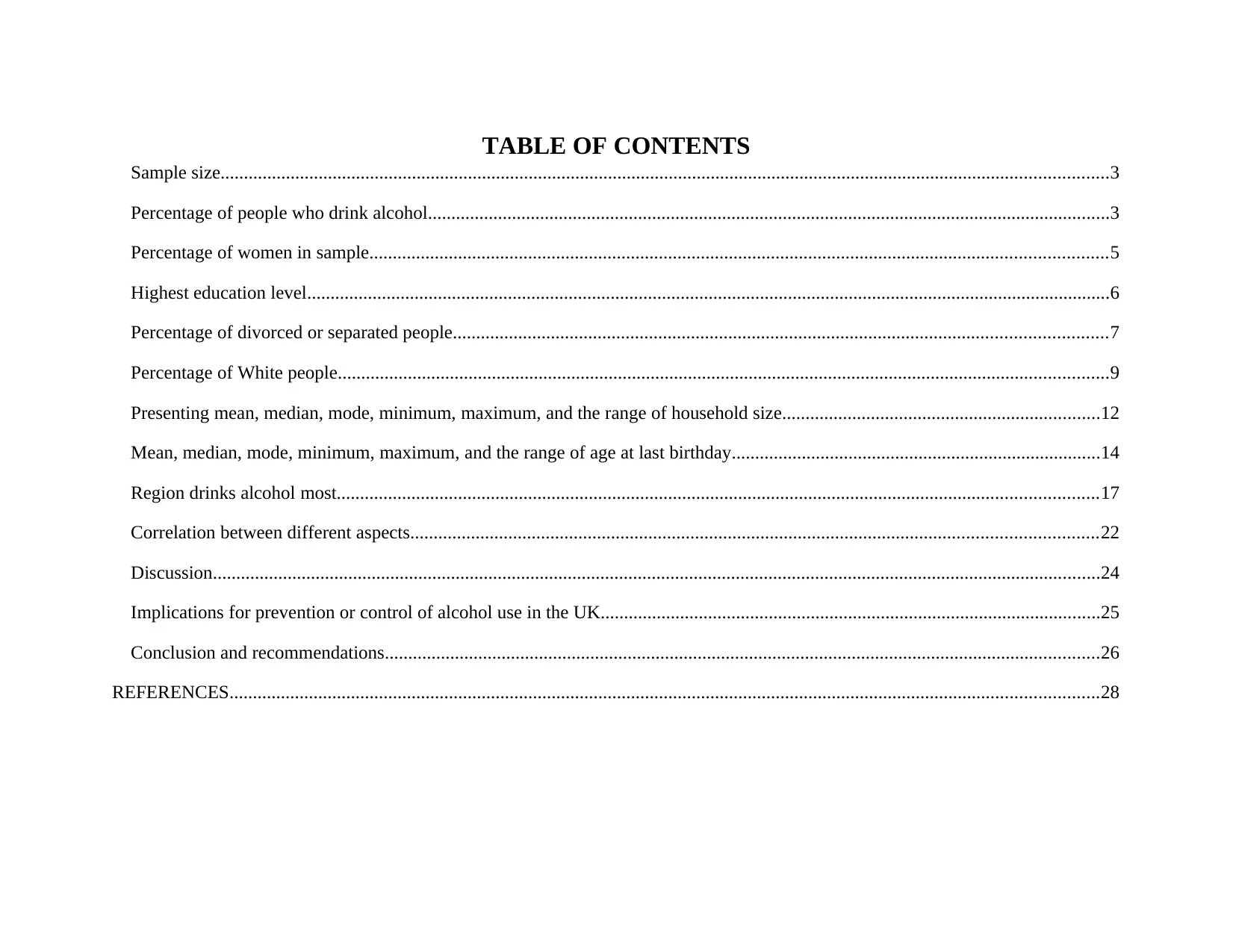
TABLE OF CONTENTS
Sample size..............................................................................................................................................................................................3
Percentage of people who drink alcohol..................................................................................................................................................3
Percentage of women in sample..............................................................................................................................................................5
Highest education level............................................................................................................................................................................6
Percentage of divorced or separated people............................................................................................................................................7
Percentage of White people.....................................................................................................................................................................9
Presenting mean, median, mode, minimum, maximum, and the range of household size....................................................................12
Mean, median, mode, minimum, maximum, and the range of age at last birthday...............................................................................14
Region drinks alcohol most...................................................................................................................................................................17
Correlation between different aspects...................................................................................................................................................22
Discussion..............................................................................................................................................................................................24
Implications for prevention or control of alcohol use in the UK...........................................................................................................25
Conclusion and recommendations.........................................................................................................................................................26
REFERENCES..........................................................................................................................................................................................28
Sample size..............................................................................................................................................................................................3
Percentage of people who drink alcohol..................................................................................................................................................3
Percentage of women in sample..............................................................................................................................................................5
Highest education level............................................................................................................................................................................6
Percentage of divorced or separated people............................................................................................................................................7
Percentage of White people.....................................................................................................................................................................9
Presenting mean, median, mode, minimum, maximum, and the range of household size....................................................................12
Mean, median, mode, minimum, maximum, and the range of age at last birthday...............................................................................14
Region drinks alcohol most...................................................................................................................................................................17
Correlation between different aspects...................................................................................................................................................22
Discussion..............................................................................................................................................................................................24
Implications for prevention or control of alcohol use in the UK...........................................................................................................25
Conclusion and recommendations.........................................................................................................................................................26
REFERENCES..........................................................................................................................................................................................28
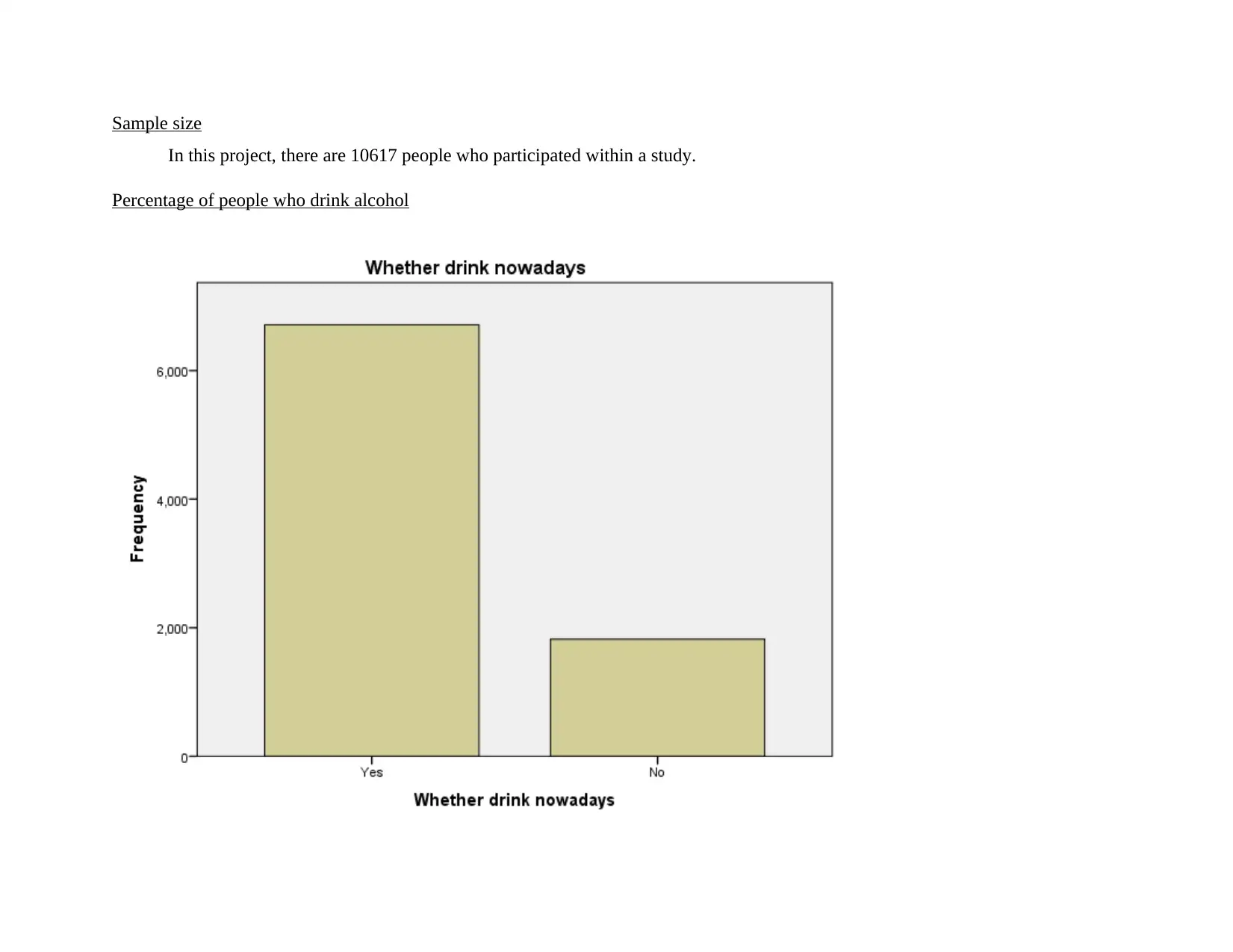
Sample size
In this project, there are 10617 people who participated within a study.
Percentage of people who drink alcohol
In this project, there are 10617 people who participated within a study.
Percentage of people who drink alcohol
⊘ This is a preview!⊘
Do you want full access?
Subscribe today to unlock all pages.

Trusted by 1+ million students worldwide
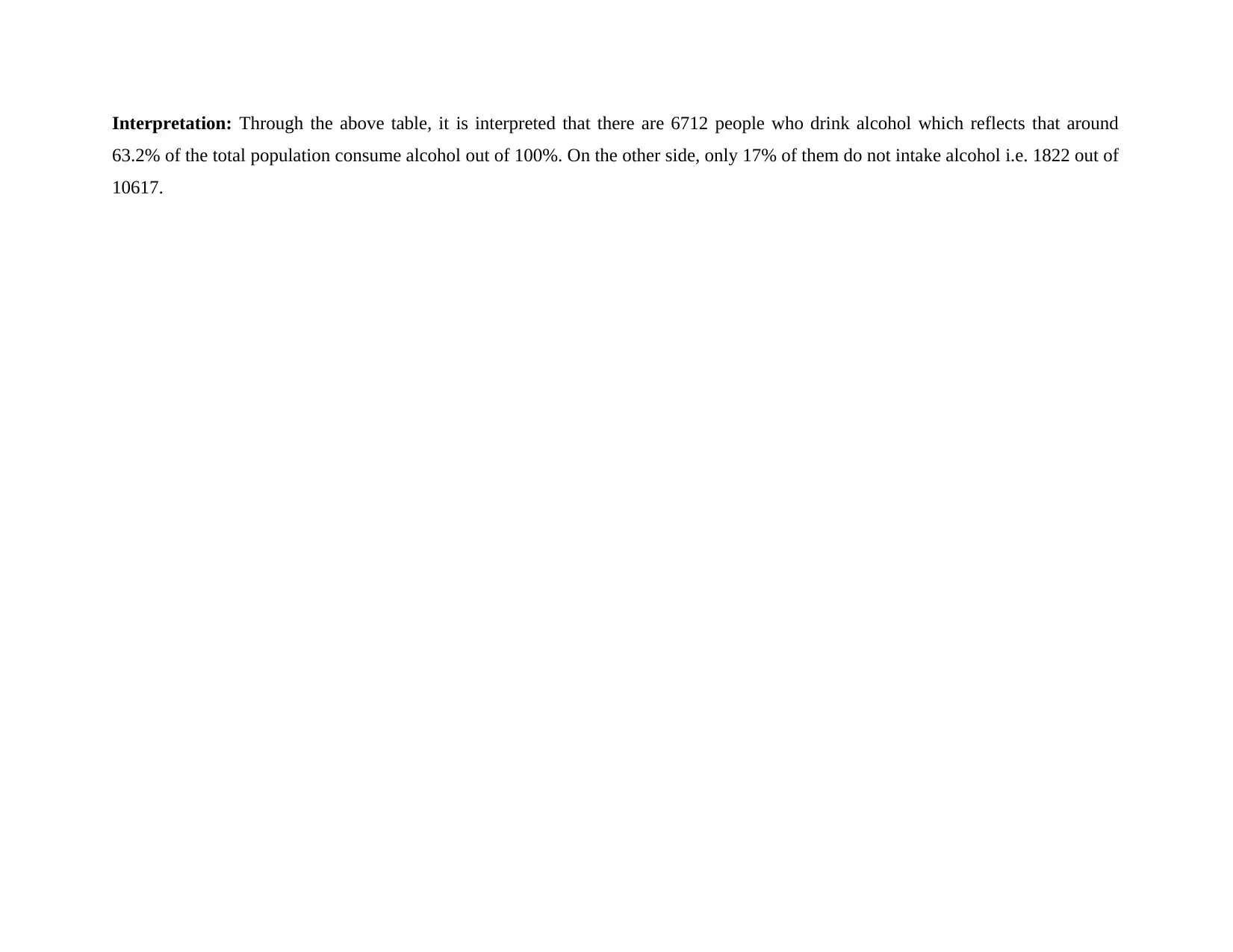
Interpretation: Through the above table, it is interpreted that there are 6712 people who drink alcohol which reflects that around
63.2% of the total population consume alcohol out of 100%. On the other side, only 17% of them do not intake alcohol i.e. 1822 out of
10617.
63.2% of the total population consume alcohol out of 100%. On the other side, only 17% of them do not intake alcohol i.e. 1822 out of
10617.
Paraphrase This Document
Need a fresh take? Get an instant paraphrase of this document with our AI Paraphraser
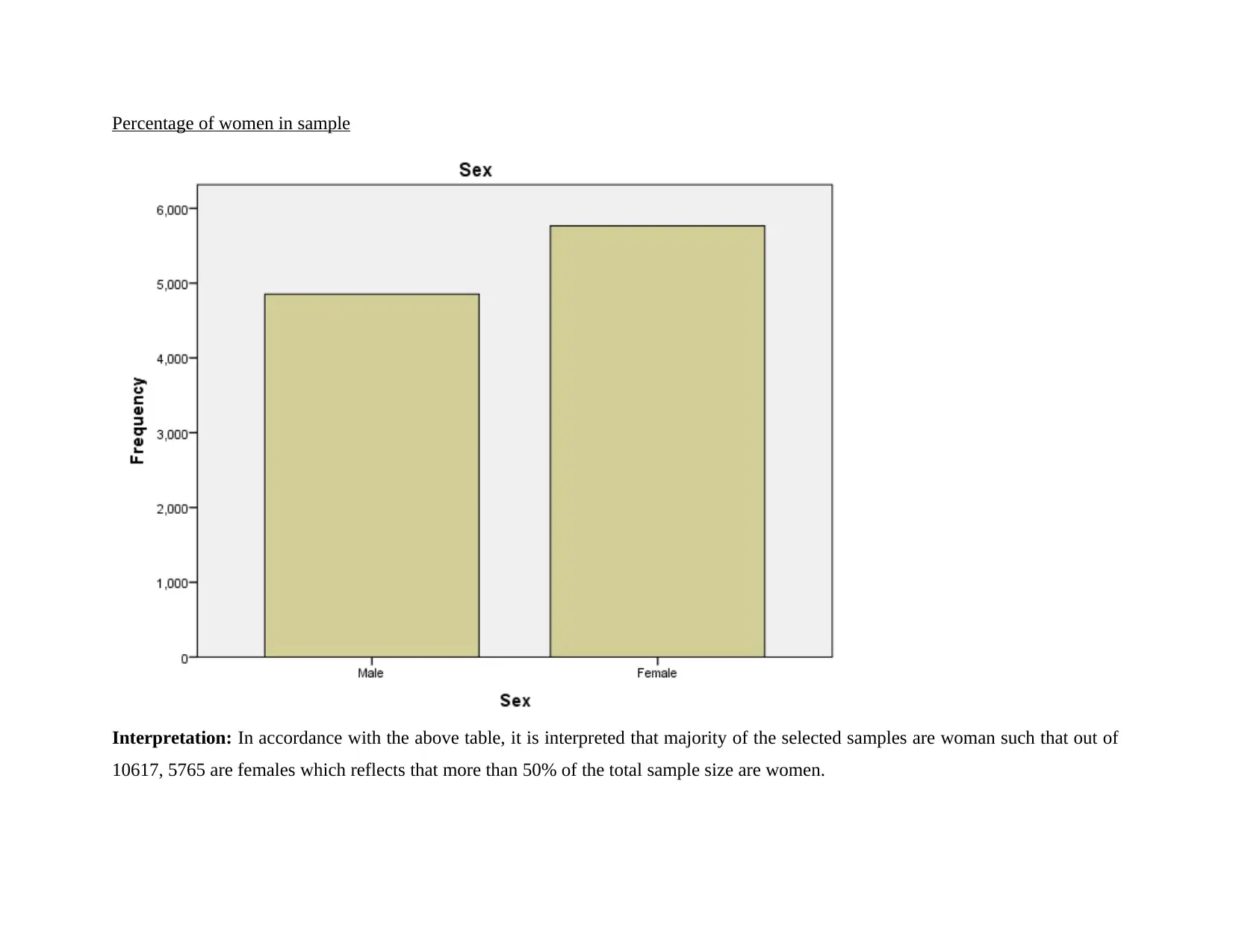
Percentage of women in sample
Interpretation: In accordance with the above table, it is interpreted that majority of the selected samples are woman such that out of
10617, 5765 are females which reflects that more than 50% of the total sample size are women.
Interpretation: In accordance with the above table, it is interpreted that majority of the selected samples are woman such that out of
10617, 5765 are females which reflects that more than 50% of the total sample size are women.
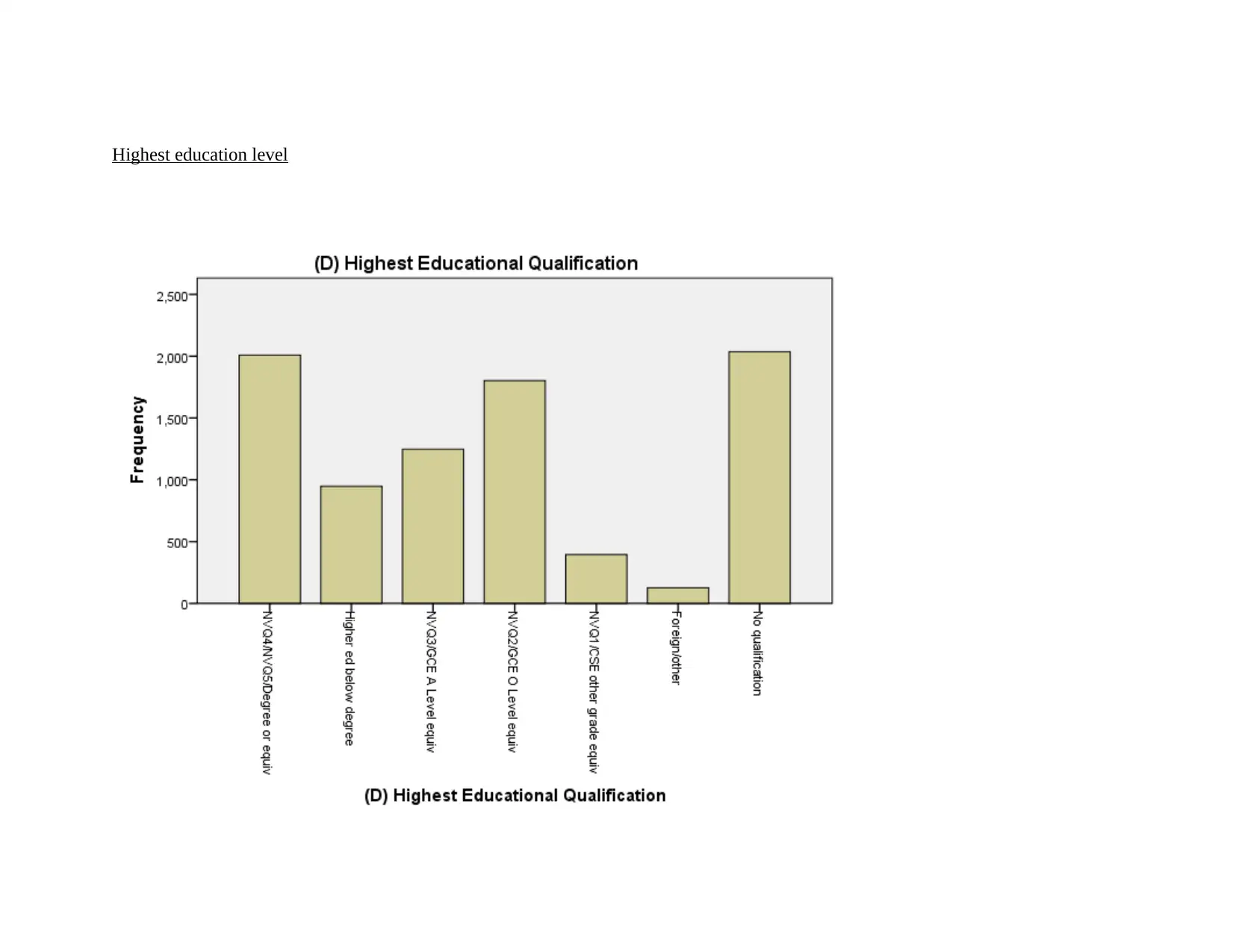
Highest education level
⊘ This is a preview!⊘
Do you want full access?
Subscribe today to unlock all pages.

Trusted by 1+ million students worldwide
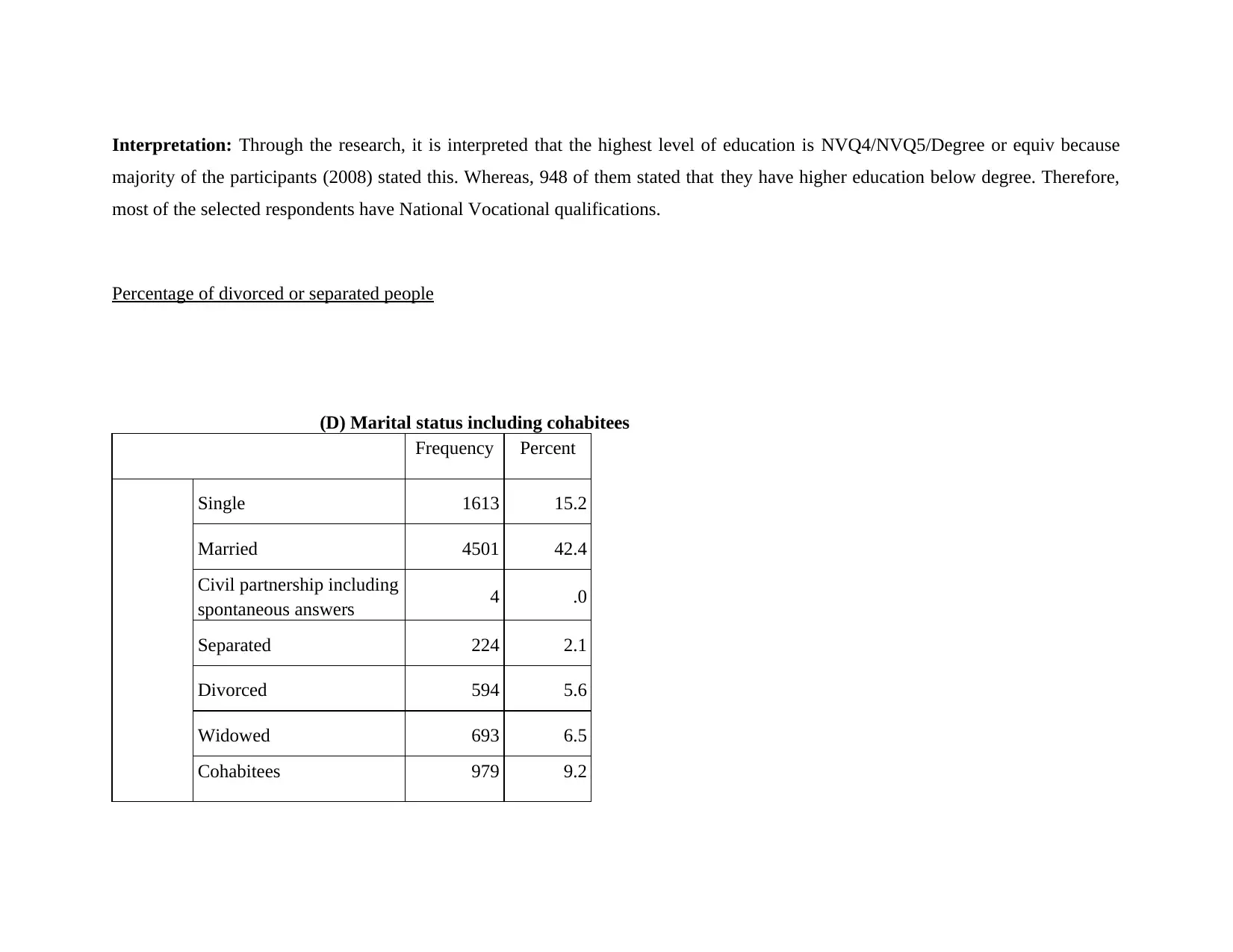
Interpretation: Through the research, it is interpreted that the highest level of education is NVQ4/NVQ5/Degree or equiv because
majority of the participants (2008) stated this. Whereas, 948 of them stated that they have higher education below degree. Therefore,
most of the selected respondents have National Vocational qualifications.
Percentage of divorced or separated people
(D) Marital status including cohabitees
Frequency Percent
Single 1613 15.2
Married 4501 42.4
Civil partnership including
spontaneous answers 4 .0
Separated 224 2.1
Divorced 594 5.6
Widowed 693 6.5
Cohabitees 979 9.2
majority of the participants (2008) stated this. Whereas, 948 of them stated that they have higher education below degree. Therefore,
most of the selected respondents have National Vocational qualifications.
Percentage of divorced or separated people
(D) Marital status including cohabitees
Frequency Percent
Single 1613 15.2
Married 4501 42.4
Civil partnership including
spontaneous answers 4 .0
Separated 224 2.1
Divorced 594 5.6
Widowed 693 6.5
Cohabitees 979 9.2
Paraphrase This Document
Need a fresh take? Get an instant paraphrase of this document with our AI Paraphraser
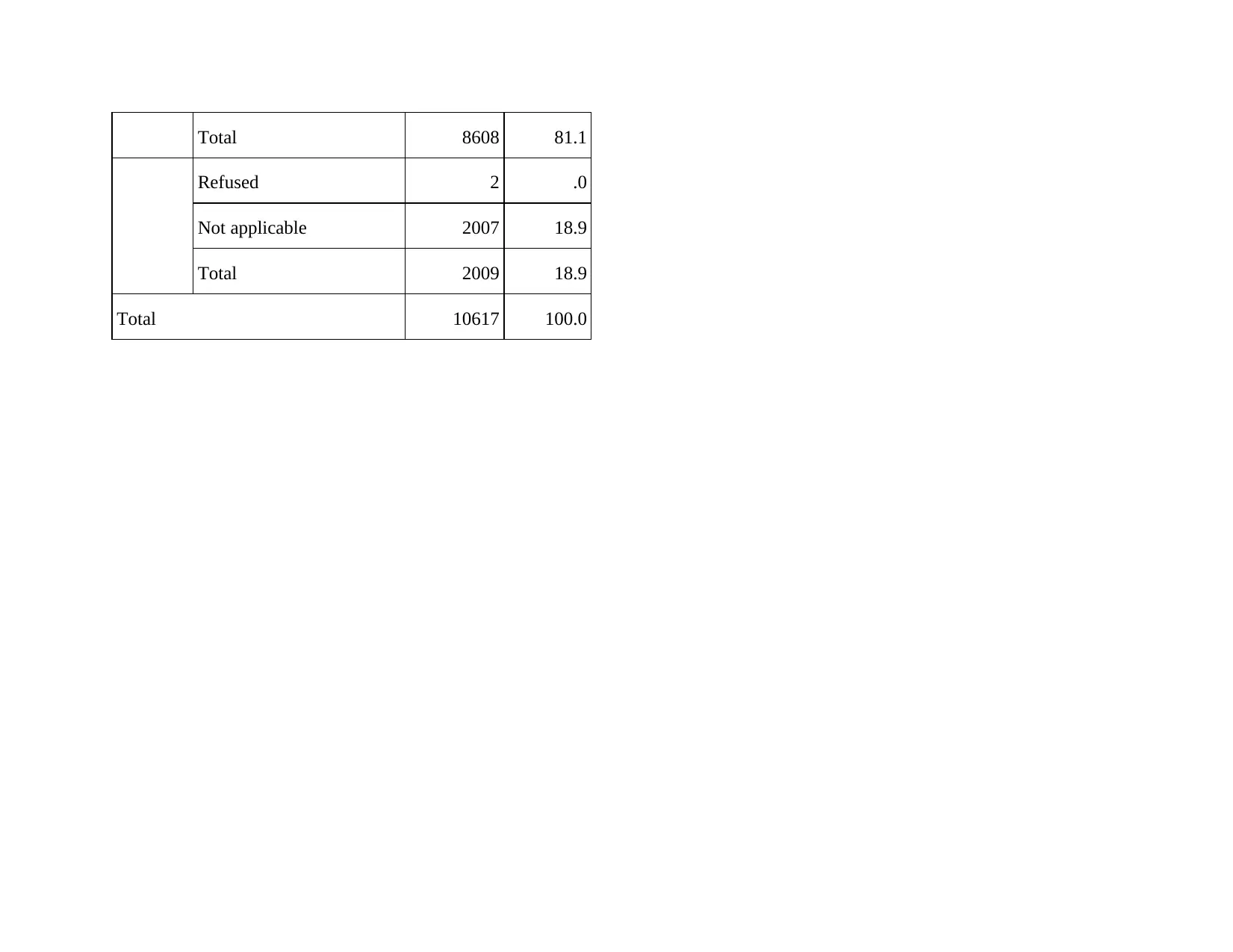
Total 8608 81.1
Refused 2 .0
Not applicable 2007 18.9
Total 2009 18.9
Total 10617 100.0
Refused 2 .0
Not applicable 2007 18.9
Total 2009 18.9
Total 10617 100.0
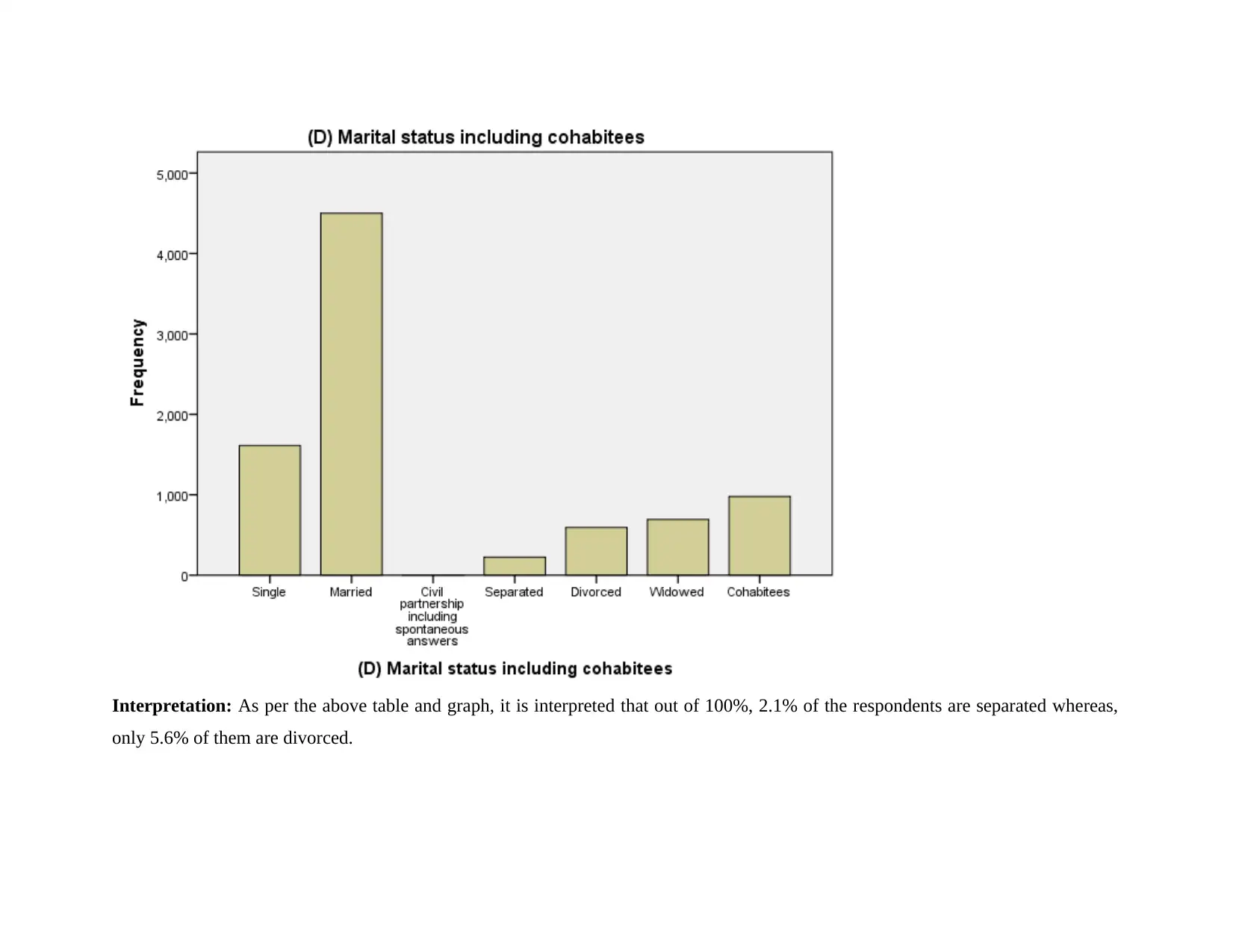
Interpretation: As per the above table and graph, it is interpreted that out of 100%, 2.1% of the respondents are separated whereas,
only 5.6% of them are divorced.
only 5.6% of them are divorced.
⊘ This is a preview!⊘
Do you want full access?
Subscribe today to unlock all pages.

Trusted by 1+ million students worldwide
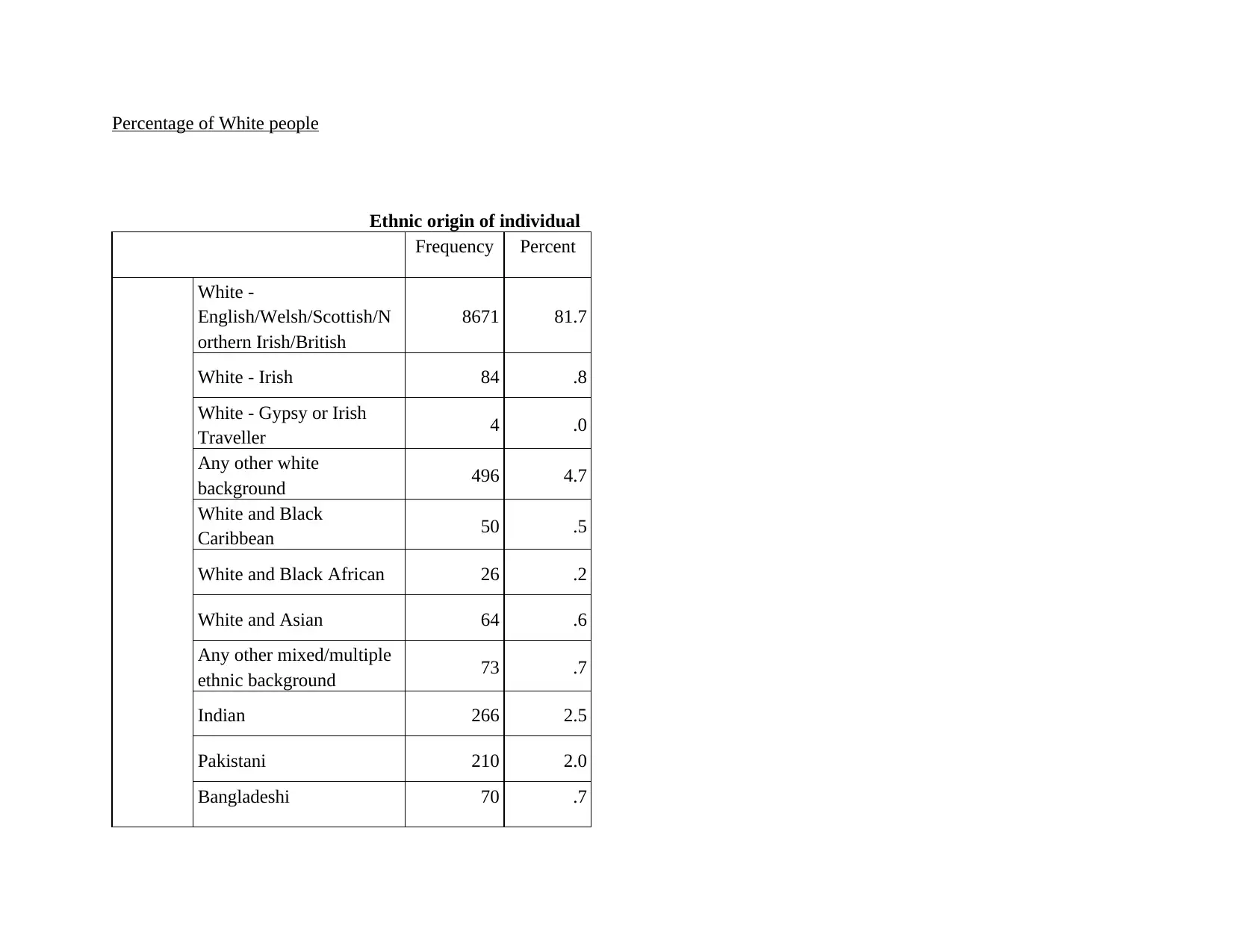
Percentage of White people
Ethnic origin of individual
Frequency Percent
White -
English/Welsh/Scottish/N
orthern Irish/British
8671 81.7
White - Irish 84 .8
White - Gypsy or Irish
Traveller 4 .0
Any other white
background 496 4.7
White and Black
Caribbean 50 .5
White and Black African 26 .2
White and Asian 64 .6
Any other mixed/multiple
ethnic background 73 .7
Indian 266 2.5
Pakistani 210 2.0
Bangladeshi 70 .7
Ethnic origin of individual
Frequency Percent
White -
English/Welsh/Scottish/N
orthern Irish/British
8671 81.7
White - Irish 84 .8
White - Gypsy or Irish
Traveller 4 .0
Any other white
background 496 4.7
White and Black
Caribbean 50 .5
White and Black African 26 .2
White and Asian 64 .6
Any other mixed/multiple
ethnic background 73 .7
Indian 266 2.5
Pakistani 210 2.0
Bangladeshi 70 .7
Paraphrase This Document
Need a fresh take? Get an instant paraphrase of this document with our AI Paraphraser
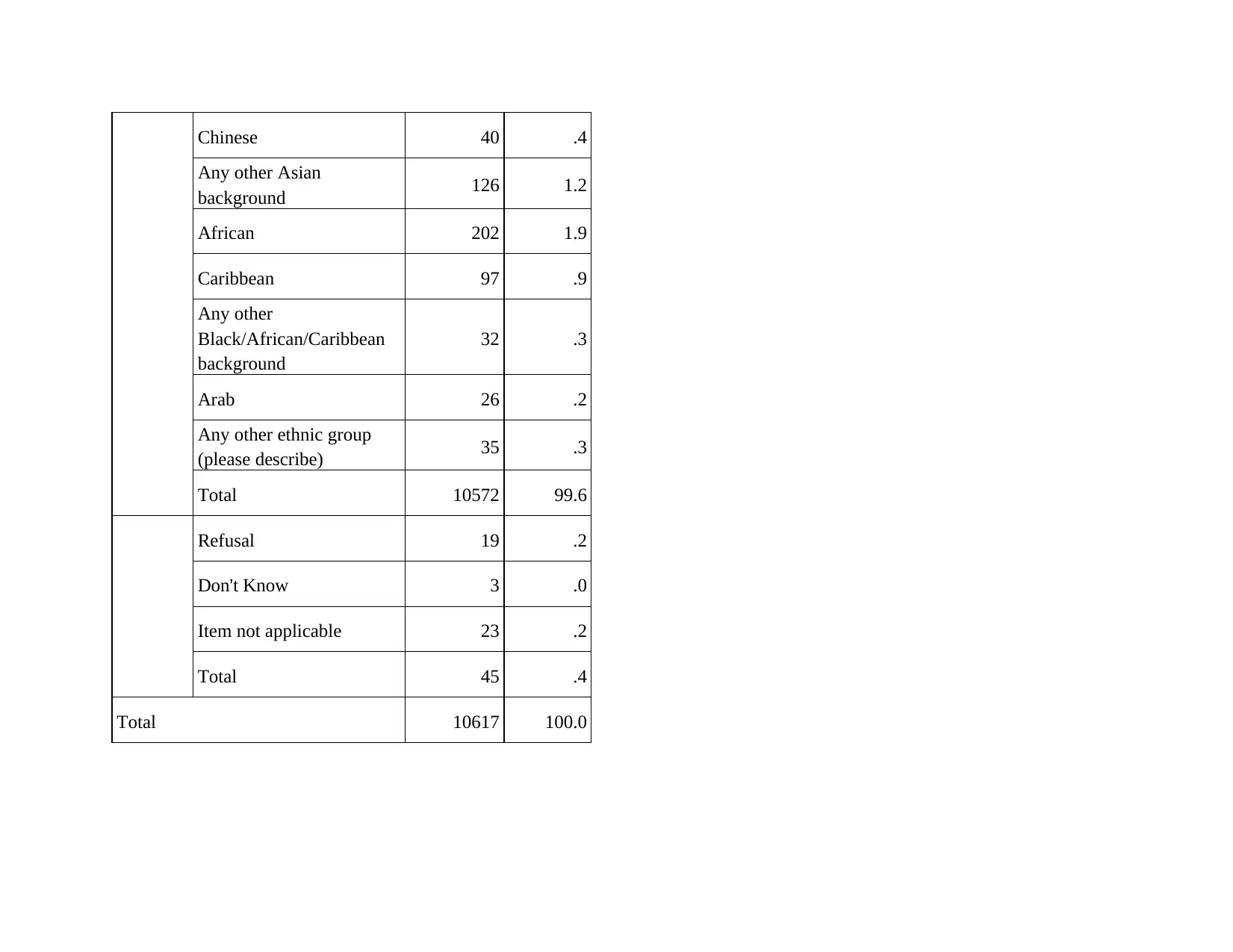
Chinese 40 .4
Any other Asian
background 126 1.2
African 202 1.9
Caribbean 97 .9
Any other
Black/African/Caribbean
background
32 .3
Arab 26 .2
Any other ethnic group
(please describe) 35 .3
Total 10572 99.6
Refusal 19 .2
Don't Know 3 .0
Item not applicable 23 .2
Total 45 .4
Total 10617 100.0
Any other Asian
background 126 1.2
African 202 1.9
Caribbean 97 .9
Any other
Black/African/Caribbean
background
32 .3
Arab 26 .2
Any other ethnic group
(please describe) 35 .3
Total 10572 99.6
Refusal 19 .2
Don't Know 3 .0
Item not applicable 23 .2
Total 45 .4
Total 10617 100.0
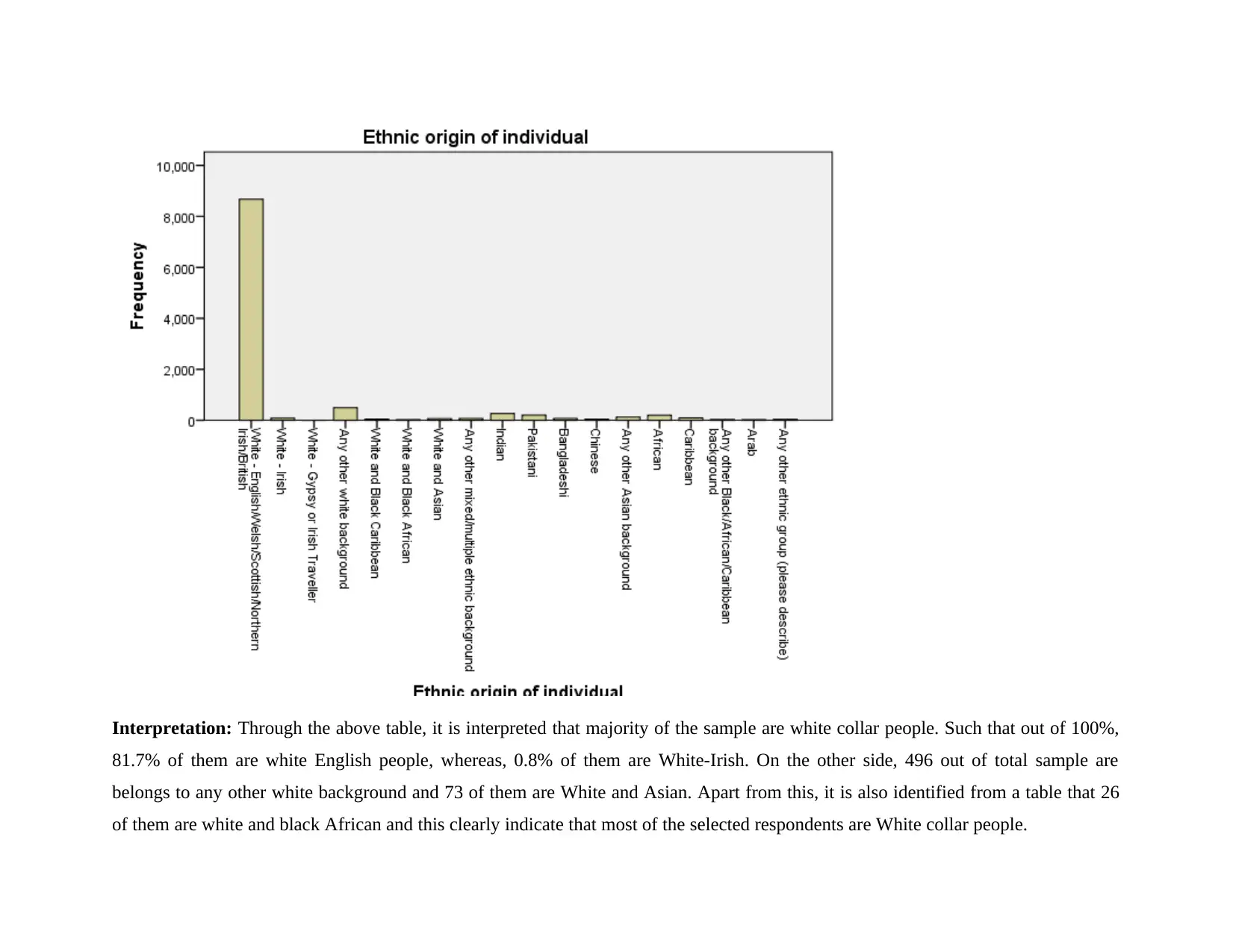
Interpretation: Through the above table, it is interpreted that majority of the sample are white collar people. Such that out of 100%,
81.7% of them are white English people, whereas, 0.8% of them are White-Irish. On the other side, 496 out of total sample are
belongs to any other white background and 73 of them are White and Asian. Apart from this, it is also identified from a table that 26
of them are white and black African and this clearly indicate that most of the selected respondents are White collar people.
81.7% of them are white English people, whereas, 0.8% of them are White-Irish. On the other side, 496 out of total sample are
belongs to any other white background and 73 of them are White and Asian. Apart from this, it is also identified from a table that 26
of them are white and black African and this clearly indicate that most of the selected respondents are White collar people.
⊘ This is a preview!⊘
Do you want full access?
Subscribe today to unlock all pages.

Trusted by 1+ million students worldwide
1 out of 29
Your All-in-One AI-Powered Toolkit for Academic Success.
+13062052269
info@desklib.com
Available 24*7 on WhatsApp / Email
![[object Object]](/_next/static/media/star-bottom.7253800d.svg)
Unlock your academic potential
Copyright © 2020–2025 A2Z Services. All Rights Reserved. Developed and managed by ZUCOL.
